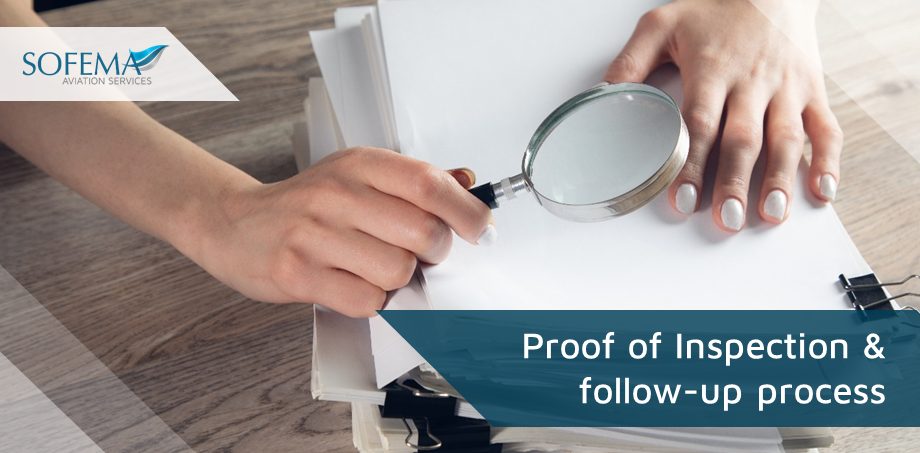Sofema Aviation Services (SAS) www.sassofia.com looks at the process to demonstrate Proof of Inspection and the follow-up process
Proof of Inspection – Ref AMC1 ARO.RAMP.125(c) Conduct of ramp inspections.
On completion of the ramp inspection, information about its results should be provided to the pilot-in-command / commander or, in his/her absence, to another member of the flight crew or a representative of the operator, using the Proof of Inspection (POI) form with reference to the 52-item checklist.
When completing the POI, the following should be taken into account:
- Only the remarks mentioned in the POI should be reported as findings in the final ramp inspection report.
- Any other relevant information which was not included in the POI should only be reported in the final report as a general remark under ‘G’ or in the additional information box.
- When handing over the POI to the pilot‐in‐command/commander or operator’s representative, the inspector should ask him/her to sign the POI whilst explaining that the signature does in no way imply acceptance of the listed findings. The signature only confirms that the POI has been received by the pilot in-command/operator representative and that the aircraft has been inspected on the date and at the place indicated.
- A refusal to sign by the recipient should be recorded in the document.
- POIs may be completed electronically, including the required signatures, and may be printed on-site or delivered electronically (e.g. by e‐mail).
Follow‐Up Actions for Category 2 or 3 findings AMC1 ARO.RAMP.135(a)
Note: Category 2 (significant) and Category 3 (major) findings require the highest attention when it comes to the need for rectification.
- Exceptionally, where multiple category 2 findings have been raised and the accumulation of these findings or their interaction justifies corrective action before the flight takes place, the class of action may be increased to the actions foreseen by ARO.RAMP.135(b).
When communicating findings to the operator, the inspecting authority should use the ramp inspection (guidelines) as the primary communication channel with the operator and limit communication via other channels.
- Request evidence of corrective actions taken, or alternatively, the submission of a corrective action plan followed by evidence that planned corrective actions have been taken
- Inform the operator’s competent authority and the operator no later than 15 calendar days after the inclusion of the report in the ramp inspection tool in order to permit appropriate action to be taken, as well as to confirm to the operator the findings raised.
- Upload in the ramp inspection tool information on actions taken and responses provided by the operator following the ramp inspection and send a communication to the operator only if the operator’s actions have not been satisfactory.
- Give the operator a period of 30 calendar days to reply.
- If the operator does not react to the initial communication within this period, a second request should be sent, including a period of another 30 calendar days to reply, whilst copying the operator’s competent authority.
- If the second attempt is also unsuccessful, the operator’s competent authority should be requested to encourage the operator to reply.
- The inspecting authority should indicate in such request that no reaction from the operator could be interpreted as a ‘lack of ability and/or willingness of an operator to address safety deficiencies’ under Regulation (EC) No 2111/2005.
Classes of Actions for Category 3 Findings – AMC1 ARO.RAMP.135(b)
- Whenever restrictions on the aircraft flight operation (Class 3a action) have been imposed, the competent authority should conduct appropriate verification of adherence to such restrictions.
- Whenever the operator is required to take corrective actions before departure (Class 3b action), inspectors should verify that the operator has taken such actions. Depending on the circumstances, this verification may take place after the departure.
- Whenever a Category 3 finding is raised, the aircraft should be grounded only (Class 3c action) if the crew refuses to take the necessary corrective actions or to respect imposed restrictions on the aircraft flight operation.
However, grounding might be appropriate if an operator refuses to grant access in accordance with ORO.GEN.140 (in case of an EU operator) or contrary to Regulation (EU) 452/2014 (in case of a third country operator).
The inspecting authority should then ensure that the aircraft will not depart as long as the reasons for the grounding remain. Any records of communication undertaken pursuant to ARO.RAMP.140(b), as well as other evidence, should be collected and kept as evidential material.
Next Steps
Follow this link to our Library to find & Download related documents for Free.
Sofema Aviation Services & Sofema Online provide regulatory compliant as well as vocational training courses please see the website or email team@sassofia.com for additional guidance.
Tags:
Aircraft, aviation, aviation safety, EASA, SAFA, Aircraft Inspection, Aircraft Operators, SACA, Regulation (EC) No 2111/2005, Ramp Inspections, Proof of Inspection, AMC1 ARO.RAMP.135(a)




